
James Fenimore Cooper was an American writer of the first half of the 19th century, whose historical romances depicting colonial and indigenous characters from the 17th to the 19th centuries brought him fame and fortune. He lived much of his boyhood and his last fifteen years in Cooperstown, New York, which was founded by his father William Cooper on property that he owned. Cooper became a member of the Episcopal Church shortly before his death and contributed generously to it. He attended Yale University for three years, where he was a member of the Linonian Society.
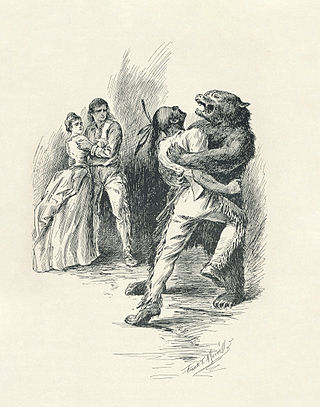
The Last of the Mohicans: A Narrative of 1757 is a historical romance novel written by James Fenimore Cooper in 1826. It is the second book of the Leatherstocking Tales pentalogy and the best known to contemporary audiences. The Pathfinder, published 14 years later in 1840, is its sequel; its prequel, The Deerslayer, was published a year after The Pathfinder. The Last of the Mohicans is set in 1757, during the French and Indian War, when France and Great Britain battled for control of North America. During this war, both the French and the British used Native American allies, but the French were particularly dependent, as they were outnumbered in the Northeast frontier areas by the British. Specifically, the events of the novel are set immediately before, during, and after the Siege of Fort William Henry.

The Leatherstocking Tales is a series of five novels by American writer James Fenimore Cooper, set in the eighteenth-century era of development in the primarily former Iroquois areas in central New York. Each novel features Natty Bumppo, a frontiersman known to European-American settlers as "Leatherstocking", "The Pathfinder", and "the trapper". Native Americans call him "Deerslayer", "La Longue Carabine", and "Hawkeye".

The Pioneers, or The Sources of the Susquehanna; a Descriptive Tale is a historical novel by American writer James Fenimore Cooper. It was the first of five novels published which became known as the Leatherstocking Tales. Published in 1823, The Pioneers is the fourth novel in terms of the chronology of the novels' plots.

Chingachgook is a fictional character in four of James Fenimore Cooper's five Leatherstocking Tales, including his 1826 novel The Last of the Mohicans. Chingachgook was a lone Mohican chief and companion of the series' hero, Natty Bumppo. In The Deerslayer, Chingachgook married Wah-ta-Wah, who had a son with him named Uncas, but died while she was still young. Uncas, who was at his birth "last of the Mohicans", grew to manhood but was killed in a battle with the Huron warrior Magua. Chingachgook died as an old man in the novel The Pioneers, which makes him the actual "last of the Mohicans," having outlived his son.

The Pilot: A Tale of the Sea is a historical novel by James Fenimore Cooper, first published in 1823. Its subject is the life of a naval pilot during the American Revolution. It is often considered the earliest example of nautical fiction in American literature. It is one of Cooper's most renowned works and is considered a classic of adventure literature. The novel follows the thrilling adventures of a mysterious and daring seafarer known as "The Pilot."
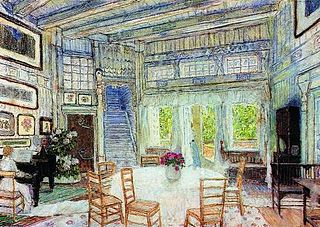
The Lady from the Sea is a play written in 1888 by Norwegian playwright Henrik Ibsen inspired by the ballad Agnete og Havmanden. The drama introduces the character of Hilde Wangel who is again portrayed in Ibsen's later play The Master Builder. The character portrayal of Hilde Wangel has been portrayed twice in contemporary film, most recently in the 2014 film titled A Master Builder.
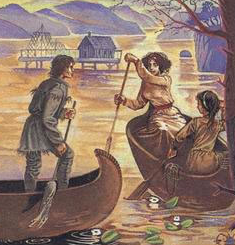
Nathaniel "Natty" Bumppo is a fictional character and the protagonist of James Fenimore Cooper's pentalogy of novels known as the Leatherstocking Tales.
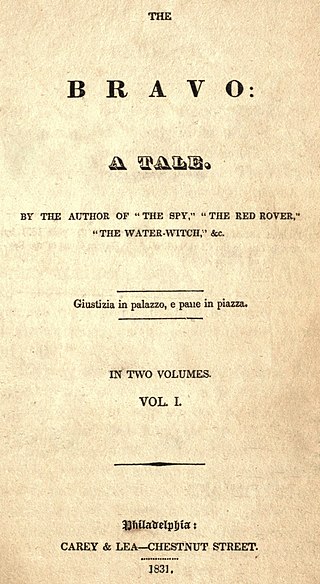
The Bravo is a novel by James Fenimore Cooper first published in 1831 in two volumes. Inspired by a trip to Europe where he traveled through much of Italy, the novel is set in Venice. The Bravo is the first of Cooper's three novels to be set in Europe. This group of three novels, which one critic would call Cooper's "European trilogy", include The Heidenmauer and The Headsman. Like his other novels set in Europe, The Bravo was not very well received in the United States. The book largely focuses on political themes, especially the tension between the social elite and other classes.
The Chainbearer; or The Littlepage Manuscripts is a novel by the American novelist James Fenimore Cooper first published in 1845. The Chainbearer is the second book in a trilogy starting with Satanstoe and ending with The Redskins. The novel focuses mainly on issues of land ownership and the displacement of American Indians as the United States moves Westward.
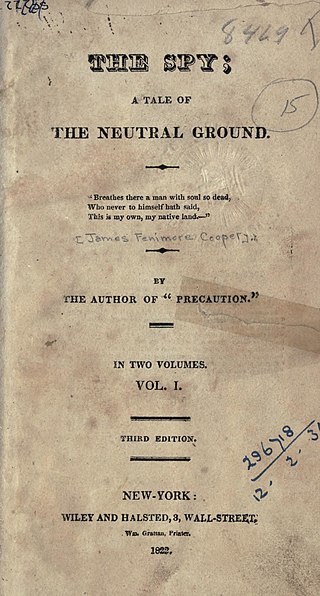
The Spy: a Tale of the Neutral Ground is a novel by American writer James Fenimore Cooper. His second novel, it was published in 1821 by Wiley & Halsted. The plot is set during the American Revolution and was inspired in part by the family friend John Jay. The Spy was successful and began Cooper's reputation as a popular and important American writer.

Nautical fiction, frequently also naval fiction, sea fiction, naval adventure fiction or maritime fiction, is a genre of literature with a setting on or near the sea, that focuses on the human relationship to the sea and sea voyages and highlights nautical culture in these environments. The settings of nautical fiction vary greatly, including merchant ships, liners, naval ships, fishing vessels, life boats, etc., along with sea ports and fishing villages. When describing nautical fiction, scholars most frequently refer to novels, novellas, and short stories, sometimes under the name of sea novels or sea stories. These works are sometimes adapted for the theatre, film and television.
Afloat and Ashore is a nautical fiction novel by James Fenimore Cooper first published in 1844. Set in 1796–1804, the novel follows the maritime adventures of Miles Wallingford Jr., the son of wealthy New York landowners who chooses to go to sea after the death of his parents. The novel ends abruptly part way through, and is followed by what critic Harold D. Langely called a "necessary" sequel which resolves many thematic and plot elements. The novel is partially autobiographical, based in part on Cooper's own experiences as a sailor, and is his first full-length novel to fully employ a first-person narrative.

Mercedes of Castile; or, The Voyage to Cathay is an 1840 historical novel by James Fenimore Cooper. The novel is set in 15th-century Europe, and follows the preparations and expedition of Christopher Columbus westward to the new world.
The Two Admirals is an 1842 nautical fiction novel by American author James Fenimore Cooper. The novel was written after the Leatherstocking Tales novel The Deerslayer. Set during the 18th century and exploring the British Royal Navy, Cooper wrote the novel out of encouragement of his English publisher, who recommended writing another sea novel. Cooper had originally intended to write a novel where ships were the main characters, though eventually decided not to. The novels is one of three novels which Cooper would revise for editions following their first printing, the other two being The Pathfinder and Deerslayer.
Wyandotté is a historical novel published by James Fenimore Cooper in 1843. The novel is set in New York state during the American Revolution. The main character of the novel is an Indian, "Saucy Nick", also called Wyandotté, whose depictions violate stereotypes of Native Americans.

The Sea Lions; Or, The Lost Sealers is an 1849 sea novel by James Fenimore Cooper. The plot revolves around two sealers stranded in the Antarctic ice. The novel was first published in two volumes, by Stringer & Townsend. Critic W.B. Gates described the novel as taking inspiration from Charles Wilkes's Narrative of the United States Exploring Expedition of the Years 1838-1842.

The Oak Openings; or, The Bee Hunter is an 1848 novel by James Fenimore Cooper. The novel focuses on the activities of professional honey-hunter Benjamin Boden, nicknamed "Ben Buzz". The novel is set in Kalamazoo, Michigan's Oak Opening, a wooded prairie that still exists in part today, during the War of 1812.
The Wing-and-Wing; Or, Le Feu-Follet is an 1842, sea novel by the American author James Fenimore Cooper. It includes a thematic interest in religiosity and faith. The novel also introduces metacriticism into Cooper's sea fiction, as does The Sea Lions, unlike earlier novels which typically also focused on nautical and nationalist themes.
The Headsman: The Abbaye des Vignerons is an 1833 novel by James Fenimore Cooper set in Switzerland. The novel was inspired by one of Cooper's trips during his European travels in 1832. The novel is one of three of Cooper's "European" novels, following The Bravo and The Heidenmauer, all of which use the European setting to deal with socio-political contrast with American institutions.














